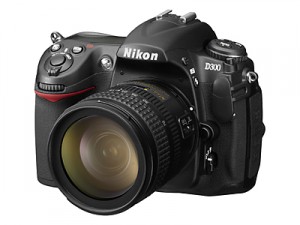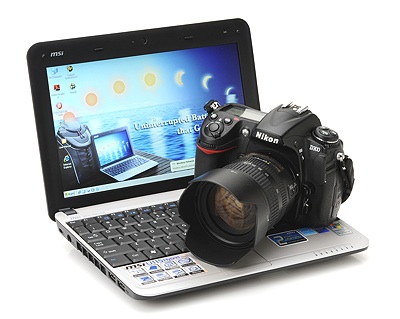Last Updated on 2020/12/06 by Radu Grozescu
 From sport to studio, products, portraits, models and architecture, and even wedding photography, Nikon D300 will do great for you. Nikon is playing a different game than the competition, delivering (semi) pro DSLRs with features and technology seen in its flagship cameras.
From sport to studio, products, portraits, models and architecture, and even wedding photography, Nikon D300 will do great for you. Nikon is playing a different game than the competition, delivering (semi) pro DSLRs with features and technology seen in its flagship cameras.
This was clearly first seen with the Nikon D200 camera with specifications quite close to the D2x and now with the D300 which is, apart from the sensor (DX vs. FX) extremely close to the D3.
Even in Nikon documentation, the D300 is clearly presented as a professional camera, and “ultimate in DX performance” which fuells hopes that Nikon is not going to abandon the DX format anytime soon.
This is not the place to talk about the superiority of FX or DX formats in different photographic fields, suffice to say that both have their strengths and weaknesses based on their intended use.
Right now the Nikon D300 represents for many photographers a viable alternative for many professional uses because both the image quality and the camera usability are pretty impressive.
This is not going to be a Nikon D300 review, there are plenty of them on the Net, but a list of the features which are going to make your life easier using this camera.

Nikon D300 on a netbook
The sensor – 12 megapixel, the highest at the moment in Nikon range, with visibly improved High ISO noise characteristics compared with the previous models. If you used D2x or D200 you will be very pleaseantly surprised to be able to shoot at 1600 ISO without major problems. Also, the sensor is covered by a very effective “dust shaking” mechanism which can de activated either manually or when you turn on and/or turn off the camera.
Internal processing – based on the new Nikon Expeed concept, it is extremely versatile and customizable, allowing you to get the right images straight from the camera. There are 4 main presets, Neutral, Standard, Vivid and Monochrome, and on each you can alter the Contrast, Saturation, Brightness Hue and Sharpness and even upload custom made curves to the camera. All the settings can be saved as new presets which can be used for different photographic tasks. More, you can save and share those custom presets between Expeed compatible cameras, making possible to share presets with other photographers or to “align” several cameras to get similar looking images.
White balance – apart from having the usual wide range of settings, those can be fine tuned on two axes, warmer/cooler and green/magenta to get the desired results. There are 5 memory slots for custom white balance which can be fine tuned too, also you can assign meaningful names to them for easier access.
Shutter lag – if you thought that the Nikon D200 was pretty fast, the D300 is noticeable faster, very close but not quite matching the D2x and D3.
8 FPS – 6 FPS with standard battery (EN-EL3e), 8 FPS with the MB-D10 grip and EN-EL4 battery or with 8 AA NiMh accus. The MB-D10 grip has a new and improved design and a much higher build quality compared with previous Nilon grips and allows having a standard battery in the camera which can back-up the grip batteries.
Buffer and writing speed – both are excellent but if you want to find out what this camera can do you should try a Sandisk Extreme IV card. For normal uses you can use slower cards because the buffer is perfectly adequate.
Shutter – the Nikon D300 shutter is optimized for 8 FPS and the estimated life is the same with previous professional models.
AutoFocus – the new CAM 3500 AF module has 51 focus points and a lot of custom settings. It is similar with the one on the D3 but on the D300 due to the DX format it covers a visibly wider part of the frame which is quite useful. The Nikon MB-D10 grip has a joystick which offers an easy way to change the focusing point when shooting vertically, another slight advantage over the D3.
AF fine tune – you can precisely calibrate your lenses if any of them exhibits front or back focus. After investing an hour or so in careful testing you will feel like having new lenses. This is another similar feature with the Nikon D3.
LCD screen – at 3″, 640×480 pixels x 3 colors it is the best of the moment, similar with the D3 one. It can be used to analize your images in the field with good acuracy and if you set medium magnification on the center click of the mlti selector the images will be shown close to 100% allowing a good sharpness assesment.
File formats – apart from the usual array of NEF, NEF + jpeg and jpeg in different sizes and compressions, the D300 has the option of looseless compressed NEFs which will save you about 40% of the card space. Also, there is the Tiff format option which allow delivering Tiffs on the spot if needed.
Commander function on the internal flash – already known from previous models and extremely useful. It even allows two manual settings for the remote flash between 1/1 and 1/2, something the SB 800 lacks. If you have a D3 you will mis this function and will need an SU800 or SB 800 as commander.
Active D-lighting – in 3 steps, allows protecting the highlights and “opens” the midtnes and shadows directly in camera. If you shoot NEFs you will be able to change the settings at the conversion stage. The major advantage is it works also when you shoot jpegs or tiffs. The effect is different than aplying D-lightning in Nikon Capture since the Active D-lighting will slighthly underexpose the image to better protect the highlights from being burnt.
Live view – a very recent feature on DSLRs, it can prove useful both for tripod and handheld shooting. The Nikon D300 has both modes and it even offers AF using a combination of phase detection and contrast detection directly on the sensor.
Viewfinder – 100% coverage, a real professional feature, extremely useful in digital photography.
Nikon Capture 2.0 – a visible improvement in usability from Capture 1.3 but still a long way to go to match the productivity possible with the old Capture 4.
What does Nikon say about the D300:
From the press release:
August 23, 2007: NIKON INTRODUCES THE NEW D300 PROFESSIONAL DIGITAL SLR CAMERA
Nikon (www.nikonusa.com) today introduced its most advanced DX-format digital SLR camera, the D300. Engineered with pro-level features and performance, the 12.3 effective megapixel D300 combines brand new technologies with advanced features inherited from Nikon’s newly announced D3 professional digital SLR camera to offer serious photographers remarkable performance combined with agility…
From the product page:
Defy Limitations – the ultimate in Nikon DX-format performance
From Nikon Europe:
Nikon is pleased to announce the D300 digital single lens reflex (D-SLR), a camera that sets new standards of compact professional performance…
The D300 is loaded with the latest professional technologies designed to produce images of the highest quality…